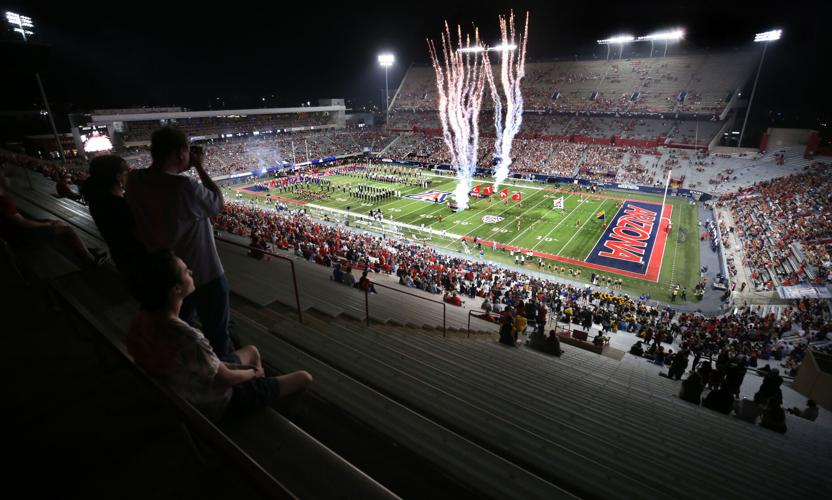The Pac-12 lost its marquee football and basketball programs, its biggest media market and the links to its main recruiting pipeline three frenetic weeks ago.
Since USC and UCLA made their flight plans known, the conference has been portrayed as everything from fragile and fractured to a carcass on the savanna awaiting vultures from the Big Ten and Big 12.
But the dire predictions seemingly overlook one important element as the conference negotiates a new media rights package: The Pac-12 offers ESPN something no other Power Five league can match.
A steady supply of night games.
“The beauty of the Pac-12 is you can program that late (Saturday) window for 13 consecutive weeks,’’ said John Kosner, a sports media consultant, president of Kosner Media and former executive vice president/digital media at ESPN.
“It takes a conference to do that, because it’s hard for individual schools to play more than a handful of those games each season.
“Let’s say you get practically a 1.0 rating and 1.5 million homes on average per (night) game. That’s considerable audience delivery for 3.5 hours every Saturday. That’s very hard to replace. It’s hard to take something away from somebody. The fact that the Pac-12 has been on ESPN for a long time — it’s part of the firmament there.”
In a twist worthy of #Pac12AfterDark, the reviled night games could play a vital role in the conference’s survival.
Yes, Larry Scott got something right.
“Nobody else can fill those time zones,” said Ed Desser, the president of Desser Sports Media and former executive vice president for strategic planning/business development at the NBA.
ESPN’s college football programming template features five windows: “College GameDay,” followed by kickoffs at 9 a.m., 12:30 p.m., 5 p.m. and late night. (Those times move up by an hour in November, when Arizona is on Mountain time).
While the late-night games lose audience when fans in the eastern half of the country go to bed, they still carry significant value for ESPN because of their unopposed nature — no other Power Five games are being played — and the 12-hour cross-promotional opportunities baked into earlier programming on ESPN.
That gives the Pac-12 an advantage over the reconfigured Big 12, which will have only one team (BYU) in the western half of the country, home to 75 million people.
“I’d argue that if ESPN lost the Big Ten, it would have the Big 12, ACC and SEC games for the Eastern and Central time zones,” Kosner said. “But without the Pac-12, it doesn’t have the Mountain and Pacific time zones.
“It can’t get those games any place else.”

Arizona running back Stevie Rocker Jr. gets knocked out of bounds by Washington defensive back Julius Irvin during their Oct. 22 game at Arizona Stadium. The game started at 7:35 p.m. and ended at 10:48 p.m.
One motivation for ESPN as it ponders a new contract with the Pac-12: affiliate fees.
The network generates immense revenue from the fees it charges distributors (DISH, Comcast, etc.) to carry its programming. Those distributors, in turn, need content that appeals to audiences in major media markets in order to drive monthly subscriptions.
“College football is an important part of ESPN’s lineup,” Desser said. “Affiliate revenue doesn’t go up or down, it’s based on the programming you have acquired. ESPN has a bunch of affiliates on the West Coast, and having the Pac-12 goes a long way to making them happy.”
Not only is the Pac-12 unique among the Power Five in its ability to fill the late windows for ESPN’s affiliates, the local markets are substantial.
The 10 remaining schools account for six of the nation’s top 30 media markets, according to Nielsen DMA data from 2021:
No. 6: Bay Area (San Francisco, Oakland, San Jose)
No. 11: Phoenix
No. 12: Seattle
No. 16: Denver
No. 21: Portland
No. 30: Salt Lake City
“You cannot replace the ratings with the Mountain West,” Kosner said. “ESPN’s affiliates on the West Coast are used to having the Pac-12.”
There’s additional value for ESPN in a region of the conference you might not expect.
While Cal and Stanford have struggled on the field and don’t drive big ratings, they reside in a huge media market that includes Big Tech firms with executives who attended Pac-12 universities and follow the conference.
“The Bay Area audience is influential,” Kosner said.
The late windows are so essential to the Pac-12’s media valuation that Kosner believes Thursday and Friday games “are prime opportunities” to explore with future network partners.
Theoretically, commissioner George Kliavkoff could offer ESPN a premium matchup each Saturday night and a secondary game every Thursday or Friday, giving the conference at least 26 night broadcasts during the regular season.
With each window spanning 3.5 hours, that’s almost 100 hours of college football programming — much of it unopposed and supported by cross-promotion.
“There are two types of valuations: marginal and intrinsic,” Desser said. “The Pac-12 has more intrinsic value because of those time slots.”
Under the current media contract with Fox and ESPN, each football broadcast is worth approximately $6 million to the Pac-12.
The loss of the L.A. schools undoubtedly will impact valuation, but any decrease could be largely offset by market forces: The value of sports rights has soared since the Pac-12 signed its media deal 11 years ago.
“We haven’t done a valuation on the late window,” Kosner said. “But the fact is the Pac-12 can program for the late window without or without the L.A. schools, and it’s not like the L.A. schools have been the highest rated. Oregon and Washington have been.
“If you’re ESPN, you want the Pac-12 to hold together.”






